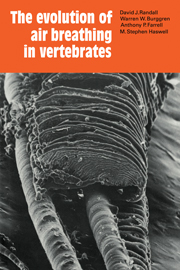Book contents
- Frontmatter
- Contents
- Preface
- 1 Introduction: air breathing in vertebrates
- 2 Gas transfer: the transition from water to air breathing
- 3 Ventilation and perfusion relationships
- 4 Mechanisms of ventilation
- 5 Regulation and control of gas transfer
- 6 The evolution of air breathing: a synthesis and summary
- References
- Index
2 - Gas transfer: the transition from water to air breathing
Published online by Cambridge University Press: 01 March 2011
- Frontmatter
- Contents
- Preface
- 1 Introduction: air breathing in vertebrates
- 2 Gas transfer: the transition from water to air breathing
- 3 Ventilation and perfusion relationships
- 4 Mechanisms of ventilation
- 5 Regulation and control of gas transfer
- 6 The evolution of air breathing: a synthesis and summary
- References
- Index
Summary
Air versus water as a respiratory medium
Air-saturated water contains about one-thirtieth of the oxygen found in an equal volume of air; even so, most vertebrates, including water-breathing fish, can maintain oxygen delivery to the tissues in the face of changes in both oxygen supply and demand. There is an ultimate level of hypoxia, however, at which an animal is unable to maintain oxygen delivery, and aerobic metabolism falls. The exact level at which this occurs varies widely with the species. When environmental oxygen levels become limiting, behavioral, physiological, and/or biochemical mechanisms are invoked which enable some animals to survive hypoxic conditions. In general, the behavioral mechanisms are to escape from the hypoxic conditions. Many fish avoid hypoxic waters by moving to skim the surface waters where the oxygen content is usually higher. Some fish species breathe air and tap the generally stable and large oxygen supply in the atmosphere. Some of these air-breathing fish, particularly those that inhabit waters that are nearly always hypoxic, are obligate air breathers. For example, the pirarucu, Arapaima gigas, relies on air breathing for most of its oxygen supply, and will die if not allowed access to the surface (Stevens and Holeton 1978).
Carbon dioxide levels in lakes and oceans vary considerably, unlike atmospheric levels, which remain very low and stable. These oscillations in CO2 levels create problems for aquatic animals, affecting CO2 excretion and therefore hydrogen ion regulation.
- Type
- Chapter
- Information
- The Evolution of Air Breathing in Vertebrates , pp. 11 - 51Publisher: Cambridge University PressPrint publication year: 1981
- 2
- Cited by



